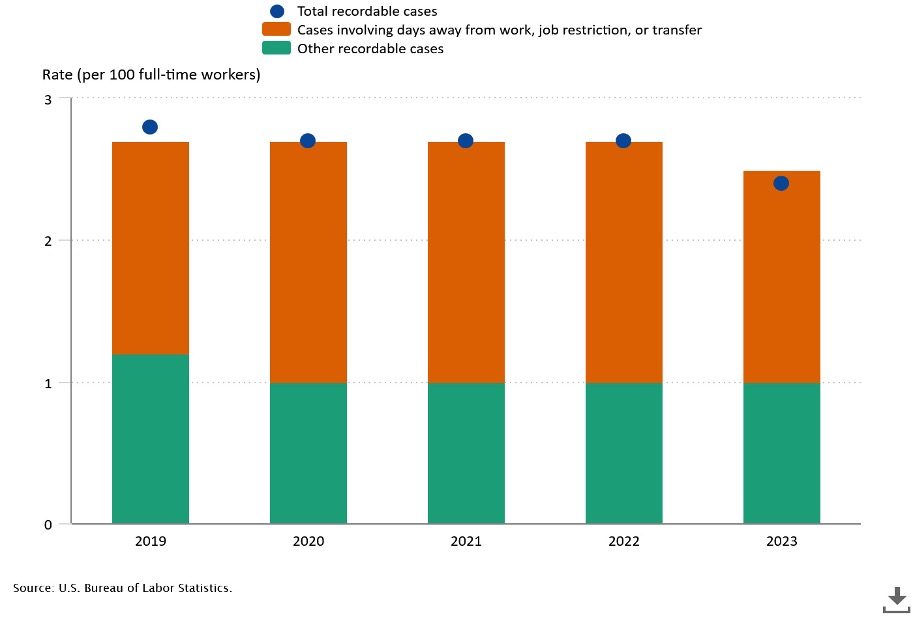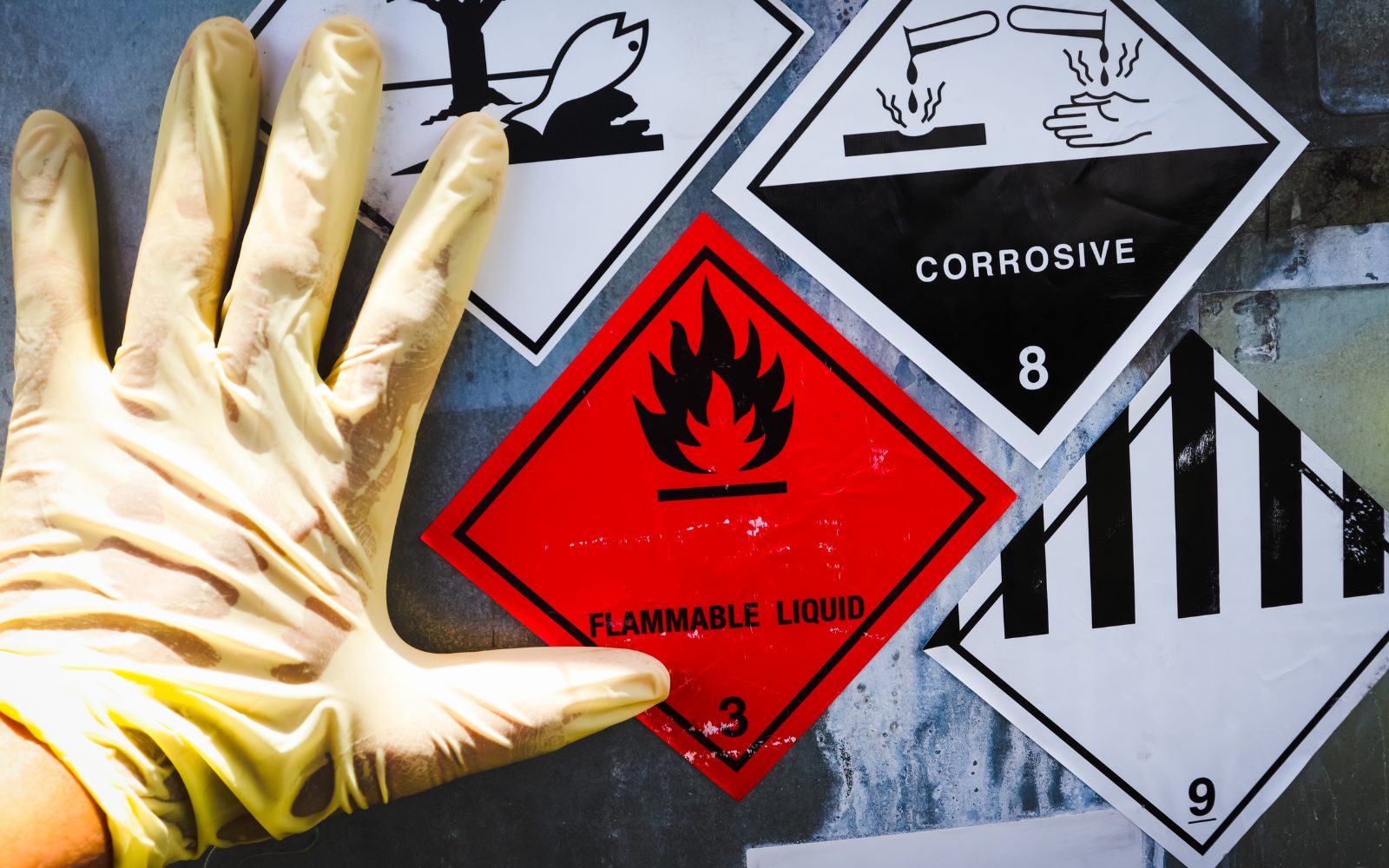- Occupational hazards remain a problem of worker safety and productivity across sectors.
- Six types of occupational hazards exist: safety, physical, chemical, biological, ergonomic, and psychosocial.
- Construction, healthcare, and manufacturing are the sectors significantly affected by most hazards.
In 2023, a worker died due to occupational hazards every 99 minutes in the USA. While the fatalities and injuries due to work-related causes are gradually reducing, there is still room for significant improvement. The types of risks and their extent will differ in each industry, but some common occupational hazards exist across sectors. In this article, owners and managers can determine these hazards to develop a suitable industrial hygiene and safety plan.
Occupational Hazards

Figure 1: “Total nonfatal work injury and illness rates, private industry,” US Bureau of Labor Statistics. (Credits: https://www.bls.gov/iif/)
Occupational hazards are risks related to work or the conditions in a workplace. Some can cause illness, injuries, or, in extreme cases, fatalities. Each employer is supposed to provide a safe and healthy work environment for their staff using the hierarchy of controls to eliminate or limit risks; however, removing all causes of hazards is often impossible. As Figure 1 shows, the total recordable cases have decreased slightly in 2023 compared to previous years. Though there has been an 8.4% reduction over 2022, there were still 2.6 million nonfatal injuries and illnesses in 2023.
There were 5283 fatal injuries in 2023, slightly lower than in 2022.
Workplace risk factors
Workplace risks indicate the chance of a hazard occurring. The factors that influence the risks of hazards are:
- Frequency: The number of times a worker is exposed to causes leading to illness or injury can determine if accidents occur. Chronic exposure that occurs frequently and regularly, like daily or weekly, increases the risks of disease and injury compared to exposure that happens seldom, like once a year.
- Exposure type: Workers can be exposed to hazards through ingestion, skin contact, or inhalation. Hazards like gases that spread in the air can affect more people.
- Extent of exposure: The extent and duration of exposure can be low, medium, or high. Chemical concentrations and the duration of exposure will increase the risk of illness and compromise worker safety.
Occupational hazard risks can be long-term and short-term, with differing effects on workers. Occupational safety and health, as well as public health, are rigorous areas of study since chemicals and biological causes can affect neighboring areas, too.
The hazards and risks will differ depending on the type of industry. However, common hazards seen across sectors are categorized into six groups: safety, physical, chemical, biological, ergonomic, and psychosocial hazards.
Some sectors will be more vulnerable to specific hazards; for example, the healthcare sector is at greater risk from biological causes. However, some common trends exist, and in the USA, workers involved with transportation are at greatest risk of occupational hazards (see Figure 2).
There are also gender differences in those affected by hazards based on the type of work; for example, men suffered more from physical, ergonomic, biological, and chemical hazards, while women suffered more from biological and psychosocial risks.

Figure 2: “Fata work injuries by selected private industry sectors and selected event or exposure in 2023,” US Bureau of Labor Statistics. (credits: https://www.bls.gov/news.release/pdf/cfoi.pdf)
-
Safety Occupational Hazards
Safety hazards are prevalent across sectors and arise due to work conditions, substances, and objects that can injure workers. Sometimes, the nature of work can itself be dangerous.
Work conditions: Situations and conditions that are dangerous are as follows-
- confined spaces
- exposed or frayed wiring
- wet or greasy floors
- cords on the floor
- steep stairways
- insufficient lighting
- absence of handrails
- clutter
Dangerous work: Working with machinery and tools accounts for a quarter of accidents, which can be due to the following causes:
- Motion: Moving and rotating parts can injure fingers and hands. Moving parts can also capture clothing or limbs and cause fractures, cuts, or burns.
- Operation points: Points or surfaces of equipment that bore, cut, or bend material can cause lacerations and wounds.
- Sparks: Machinery and equipment can generate sparks, chips, and material/chemical spray that can irritate the eyes and skin, and are also a fire risk.
-
Physical Occupational Hazards
Physical hazards result in injury and illness in many sectors. It was the second leading cause of fatalities due to occupational hazards in the USA in 2023, see Figure 2. Causes of physical hazards can be exposure to one or more of the following:
- Extreme temperature. Low and high
- Excessive noise
- Radiation- X-rays, radioactive materials, or radiofrequency radiation
- Vibration
- Work during bad weather
These hazards are unavoidable in many industries, such as construction or mining. In a 2023 study in France, the percentage of workers who reported exposure to physical dangers according to industries is as follows:
- 76% of workers in the construction industry reported exposure to physical hazards
- 60% in the manufacturing sectors
- 38% in administrative and support
-
Chemical Occupational Hazards
Chemical hazards were the third major cause of occupation-related fatalities across several industries (Figure 3). Chemical hazards vary according to type, frequency, and extent of exposure. Workers can be exposed to dangerous solids, liquids, and gases through ingestion, skin contact, or inhalation.
Exposure to chemicals can occur due to various causes:
- Handling chemicals used as ingredients or raw materials, such as insulation wool, etc.
- Exposure to chemicals formed as products or byproducts can be fumes, accidental leaks or spills, dust, and fibers such as asbestos.
The three types of chemicals involved in occupational hazards are:
Toxic chemicals are dangerous and everyday items like cleaners, solvents, emissions, medication, etc. Chronic and acute exposure to chemicals can cause various illnesses and sometimes result in fatalities. The frequency and concentration of chemicals involved can be crucial. Therefore, government agencies have standards that establish permissible levels of gases that can be present in the working environment. Common toxic chemicals include pesticides, formaldehyde, chlorine, and hydrogen sulfide.
Flammable chemicals: Some substances used or generated in industries can be combustible and cause fires and explosions, resulting in loss of lives and damage to facilities. These can be turpentine, chemicals in fuels, resins, or acetone. Besides being a fire hazard, they can also be health risks, like paints.
Corrosive chemicals: A few substances are very reactive and can harm tissue, causing burns or death. Caustic chemicals can also react with metals to weaken infrastructure in facilities, posing additional dangers for workers. Examples of corrosive chemicals are acids, parabens, paints, and gases.
Some of the sectors most affected by chemicals are as follows:
- 75% of workers at construction reported exposure to chemicals
- 59% of manufacturing workers are exposed to chemical risks
- 39% of social and human health workers are affected by chemicals
Engineering controls, protective personal equipment, timely evacuations, and sensors to detect fumes can limit chemical hazards.
-
Biological Occupational Hazards
Biological hazards can arise from diseases, pests, or people.
The origins of biological hazards are as follows:
- Working with people or human products/waste
- Working with animals or animal products
- Waste disposal and treatment sites
- Jobs in the food industry and processing in open environments
The possible biological hazards are listed below:
- Fecal matter
- Blood
- Bodily fluids
- Bacteria
- Viruses
- Fungi and molds
- Stinging insects
- Medical waste
- Animal fur or scat
Biological hazards can spread diseases and cause respiratory problems like asthma due to exposure to fur.
In France, the sectors that had the most biological hazards were as follows:
- 69% of workers in healthcare and social services
- 21% in public administration
- 14% in administrative and support services
-
Ergonomic Occupational Hazards
Ergonomic or biomechanical risk factors occur in many jobs.
Ergonomic risks can be one or more of the following:
- Repetitive actions
- Heavy lifting
- Awkward positions
- Prolonged postures
- Improperly designed workstations or chairs
- Tasks with vibrations
These risks result in fatigue, physical stress, body aches and pains, numbness, worn-out muscles, tendons, and nerves. The result can be musculoskeletal disorders, pain, and weakness that affect productivity and create safety issues.
Industries most affected by ergonomic or biomechanical risks are as follows:
- 82% of workers in construction
- 76% in health and social work
- 72% in manufacturing
Workstations that make people comfortable and safe can improve productivity and staff health.
-
Psychosocial Occupational Hazards
Around 71-90% of workers from all sectors reported psychosocial hazards. These hazards are related to social, economic, mental, and emotional issues.
Factors that cause psychosocial hazards can be:
- Work requirements
- Support and recognition (or their lack) from the employer, supervisor, and colleagues
- Conflict with supervisor, employer, and colleagues
- Work organization and autonomy
- Long or atypical working hours
- Gender and racial discrimination
- Workplace violence and sexual harassment
Psychosocial hazards can cause stress, hypertension, cancer, psychological illness, and violence, which can sometimes lead to death.
The sectors that reported the most psychosocial hazards are the following:
- 90% of workers are affected in human health and social work
- 85% in public administration
- 80% in manufacturing
Employers can control and limit many factors that cause occupational hazards. A safe and healthy workplace improves worker morale, brand image, productivity, and profits.
Gas Detectors Improve Occupational Safety and Health
Employers should do their best to prevent hazardous accidents to ensure staff health and not make just minimal changes for compliance. Precision detectors for hazardous gases will help employers maintain these chemicals under permitted levels and keep their staff and facility safe. Interscan offers fixed and portable gas detectors for over 20 hazardous gases with varying measurement ranges, increasing their application in industries.
Learn more about Interscan gas detectors and how we can help reduce occupational hazards in your facility.
Sources
Biswas, A., Harbin, S., Irvin, E., Johnston, H., Begum, M., Tiong, M., … & Smith, P. (2021). Sex and gender differences in occupational hazard exposures: a scoping review of the recent literature. Current environmental health reports, 8(4), 267-280.
Bureau of Labor Statistics. (2024, Dec 19). National census of fatal occupational injuries in 2023. Retrieved from https://www.bls.gov/news.release/pdf/cfoi.pdf
Bureau of Labor Statistics. (n.d.). Injuries, Illnesses, and Fatalities. Retrieved from https://www.bls.gov/iif/
Cornell Law School. (n.d.). Occupational hazard. Retrieved from https://www.law.cornell.edu/wex/occupational_hazard
Dogbla, L., Gouvenelle, C., Thorin, F., Lesage, F. X., Zak, M., Ugbolue, U. C., Charbotel, B., Baker, J. S., Pereira, B., & Dutheil, F. (2023). Occupational Risk Factors by Sectors: An Observational Study of 20,000 Workers. International journal of environmental research and public health, 20(4), 3632. https://doi.org/10.3390/ijerph20043632
OSHA. (n.d.). Hazard Identification and Assessment. Retrieved from https://www.osha.gov/safety-management/hazard-Identification
Shaw, S. (2023, Jul 3). Occupational Hazards: An Overview. Retrieved from https://www.webmd.com/a-to-z-guides/occupational-hazards
Tulane University: (2022, June 17). Types of Hazards in the Workplace. Retrieved from https://publichealth.tulane.edu/blog/types-of-hazards-in-the-workplace/


